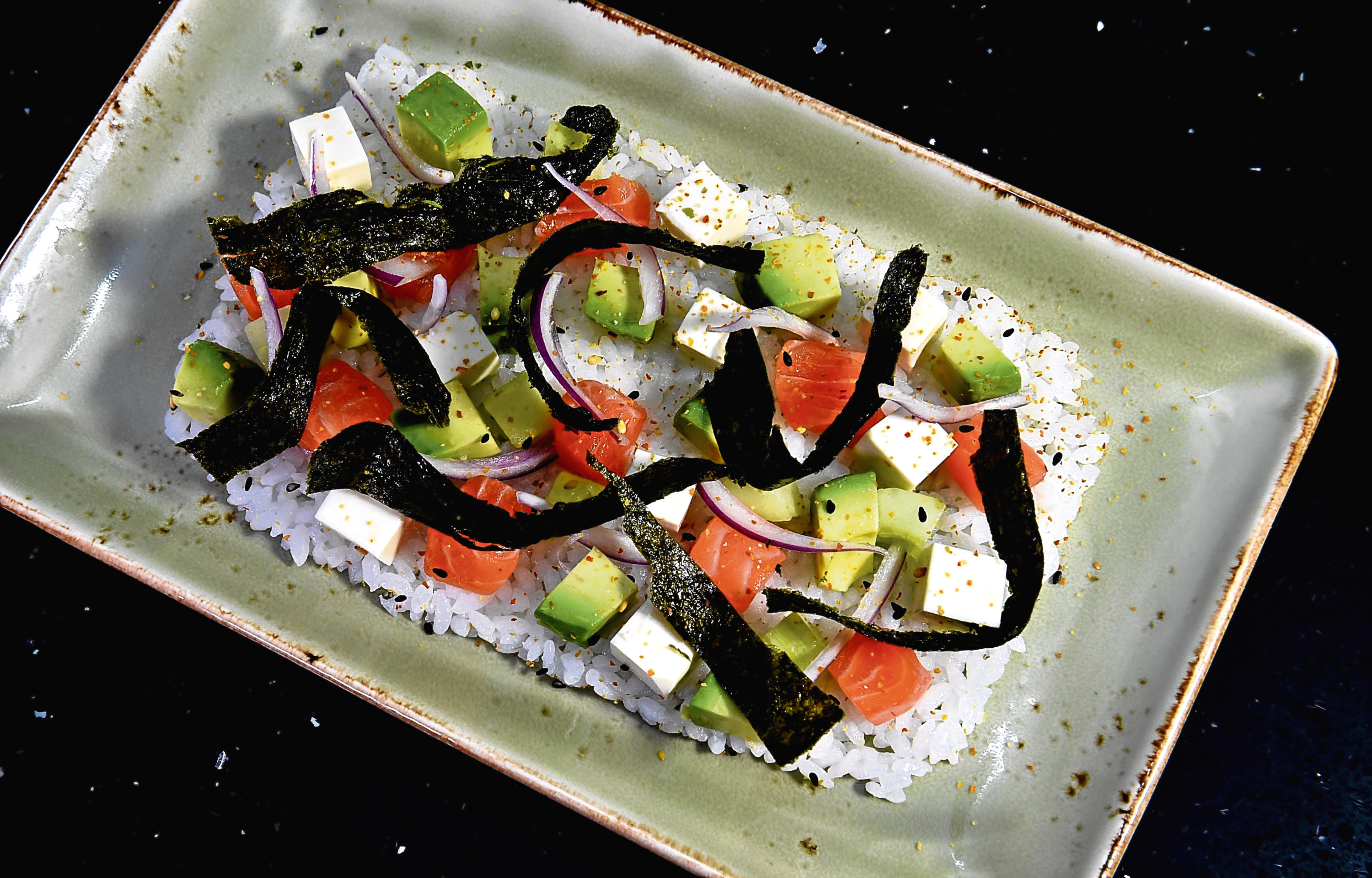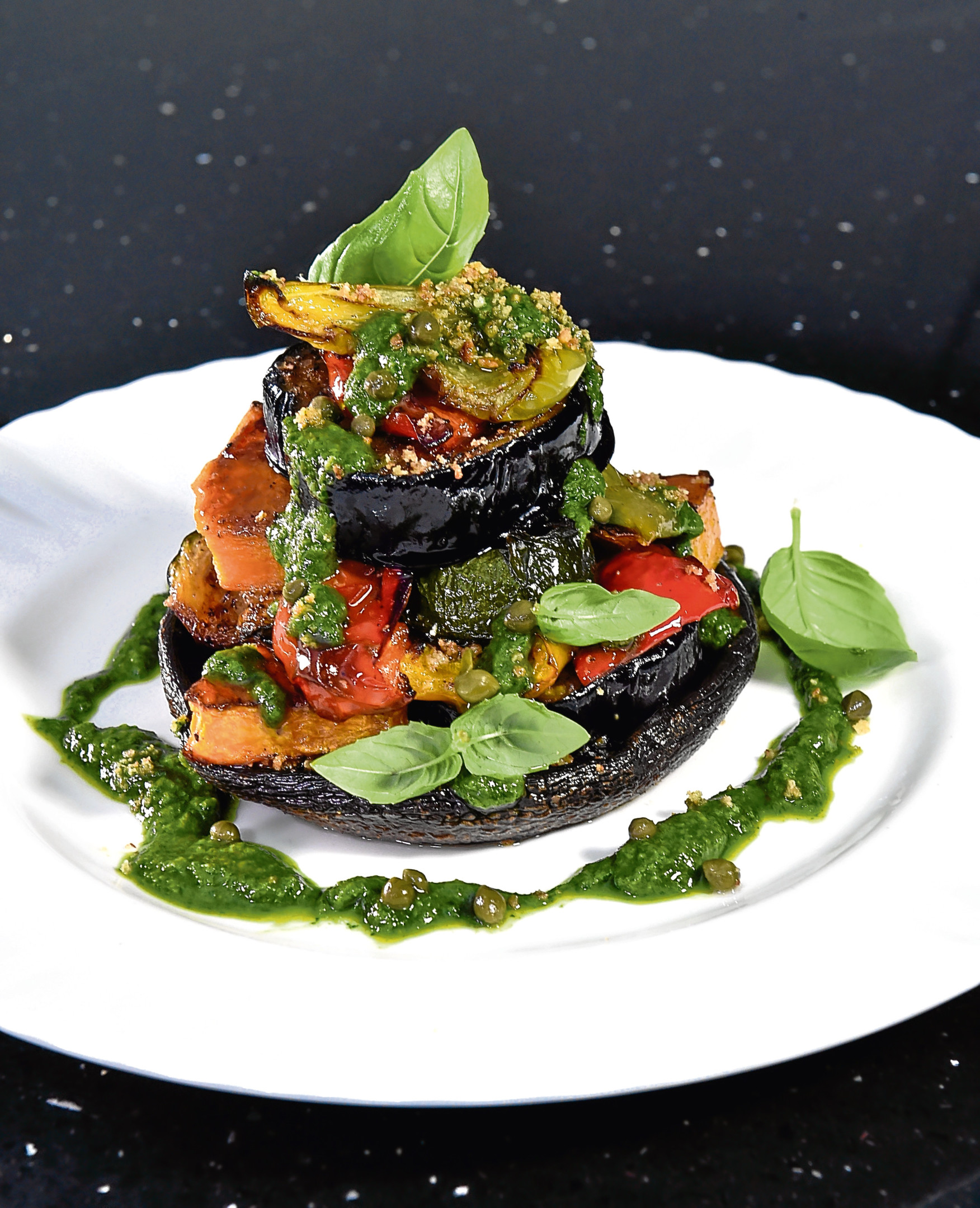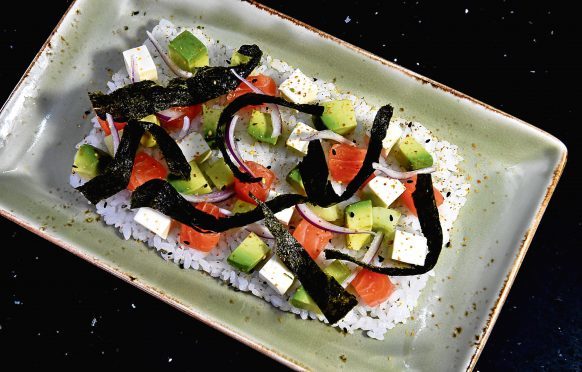By the time the end of January swings into view, many of us can feel fed up eating warming but perhaps heavy, meat-based dishes. It’s also the month when Veganuary takes place, when people are encouraged to try going vegan.
As it’s a time for resolutions, others may have decided to eat more vegan, vegetarian or pescatarian dishes, so with that in mind, I have created two vegan dishes, both of which can easily be altered to make them appeal to pescatarian.
The inspiration for the first dish, deconstructed sushi, grew from the idea of sushi rolls. Here I’ve taken all the elements used in sushi rolls such as rice and seaweed and make it into more of a restaurant-style dish.
If you like fish, use salmon as per the recipe below, but if you want to make it strictly vegan, swap the salmon for chunks of peeled and de-seeded cucumber.
The second recipe, Stuffed Portobello Mushrooms, is a delicious dish which can be eaten at any time of the year. As all the veg is cooked at the same temperature, it’s a fuss-free meal to put together. The trick is to remember not to cram all the veg for roasting onto one tray as this may result in the veg being steamed rather than roasted.
Deconstructed Sushi
SERVES 2

The ingredients
- 15ml rice wine vinegar
- 2 tsp caster sugar
- Half a tsp fine salt
- 60g sushi rice
- 150ml water
- For the topping:
- 60g peeled and de-seeded cucumber OR 60g raw or smoked salmon
- 1 avocado
- 60g tofu
- Quarter of a red onion, finely shredded
- 1 sheet Nori seaweed
- Half a tsp Japanese seven spice (or wasabe and 2tsp sesame seeds)
- 2 tsps pickled ginger, finely chopped
The method
- Place a small pan on the hob. Add the rice wine vinegar, sugar and salt and bring to the boil, stirring to dissolve the sugar and salt. Once dissolved, set aside to cool. Wash the sushi rice three or four times in cold water, and set aside in the colander for 30 minutes.
- Place the rice into a saucepan then add 150ml water. Cover the rice and bring to the boil over a low heat. Boil for 8-10 minutes until the water has been absorbed, then remove the pan from the heat, keeping the lid on, and allow to finish cooking off the heat for 10 minutes more.
- Tip the rice into a wide bowl and fold in the cooled sushi vinegar to make the rice sticky.
- Divide the rice into two portions, and using the back of a wet spoon spread across two nine-inch plates. A good tip is to keep the spoon wet at all times as this stops the rice from sticking. Once you have a nice, thin layer of rice on each plate, they can be covered in cling film and kept in the fridge for up to 24 hours.
- Just before you are ready to eat, dice the salmon or cucumber, tofu and avocado into small chunks, about the size of your middle fingernail. Arrange these on top of the sticky rice. Scatter the finely shredded red onion on top, along with the chopped pickled ginger.
- Shred the seaweed and place on top. For extra flavour and texture, cut the sheet into strips and deep fry at around 170o for around 15 seconds, before sprinkling on top.
- Finally, sprinkle the Japanese seven spice across both plates. If you don’t have this spice, sprinkle with sesame seeds and add dots of wasabe.
Stuffed Portobello Mushroom with Roast Vegetables and Salsa Verde
SERVES 4

The ingredients
- 4 large Portobello mushrooms
- 1 fat clove of garlic, finely sliced
- 1 red pepper
- 1 green pepper
- 1 yellow pepper
- 1 courgette
- 1 small aubergine
- 1 red or green chilli
- Half a butternut squash
- Olive oil
- 2 slices white bread
- For the salsa verde
- 1 small bunch of mint
- 1 small bunch of basil
- 1 small bunch of coriander
- 40g of mixed herbs
- 4 tblsps olive oil
- Salt and pepper
- 1 clove garlic
- 1 tsp Dijon mustard
- 1 tblsp capers
- 2 or 3 gherkins
- 1 tsp lemon juice
- 4 anchovies (optional)
The method
- Dice into cubes around 2cm, the peppers, courgette, aubergine and butternut squash. Spread the veg across two roasting tins (allow plenty of space between the veg to avoid them steaming). Drizzle each tray of veg with between 2-3 tbsp olive oil and give the veg a good mix round to ensured they are covered in the olive oil.
- Roughly chop and remove the seeds from 1 red or green chilli and divide it between the trays. Season with salt and pepper and place both trays in the oven at 180o for about 25 minutes.
- Dived the sliced garlic between the four large mushrooms and roast in the oven at 180o for about 15 minutes, until they are tender.
- Cut the crusts off two slices of fresh, white bread. Place in a food processor and blitz until it forms breadcrumbs. Add around 4 tbsp olive oil to a frying pan, heat then fry the breadcrumbs until crisp and golden. This will take around 5-10 minutes.
- To make the salsa verde, place all the ingredients (only add the anchovies if you want to make a non-vegan version) in a bowl, and using a stick blender, blitz until it forms a pesto-style paste. Season to taste, then add a small tsp of lemon juice.
- To assemble, remove the mushrooms from the oven. Fill with the diced, roasted veg. Top with the fried breadcrumbs, then drizzle the salsa verde over and around each mushroom and serve.
